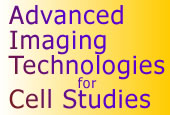
Research Interests |
||
| Polymer Physics of F-Actin Networks Because the physics of a network of semiflexible polymers is poorly understood, insights into F-actin networks are immediately relevant for other semiflexible polymers. Biological polymers that are semiflexible include DNA, intermediate filaments, and microtubules. Not only measuring power-law relationships for F-actin mechanics (Palmer et al. 1999), we have discovered new phenomena. Like armor-piercing bullets, anti-stick particles are able to penetrate deeply into networks despite their high density of filaments and crosslinking (McGrath et al. 2000). This surprising discovery has important implications for organelle and particle trafficking in living cells. > Learn more about this project . . . |
||
| Bacterial Pathogens To understand cell motility, we have exploited the abilities of bacterial pathogens to control cytoskeleton. For example, after lysosomal/vacuolar escape into host cytoplasm, Listeria monocytogenes recruits host factors to assemble F-actin “rockets” (movie 683Kb) that help propel bacteria into adjacent cells, thus avoiding detection by the humoral immune system. Because it uses a minimal set of host proteins for propulsion, Listeria is also a model for host cell motility and elegant biophysical mechanisms have been proposed. Using high-resolution laser-tracking of Listeria motility, we showed that 1) existing biophysical models are wrong or incomplete, and 2) bacteria can move with step-like motion along actin filaments as they polymerize (Kuo & McGrath 2000). By studying such new phenomena, we have a unique opportunity to formulate guiding theories about cell motility. > Learn more about this project . . . |
 |
|
| Optical Engineering For measuring microscopic mechanical forces, we have developed two noninvasive, complementary tools: laser-based particle tracking with Angstrom-level resolution, and optical forces (laser tweezers) with subpiconewton force resolution (Kuo & Sheetz 1993). Based on high-resolution tracking, we invented a new technique, laser-tracking microrheology (LTM, Mason et al. 1997) that provides revolutionary abilities for characterizing mechanical properties in living cells (Yamada et al. 2000). > Learn more about this project . . . |
 |
|
| Phagocytosis and Therapeutic Delivery The target of many pharmaceutical delivery systems, including drugs and gene therapy, phagocytosis, or particle uptake, is a mechanical function of cells requiring remodeling of cytoskeleton. We are the first to quantify the forces during extremely fast uptake of artificial particles by macrophage-like cell, Dictyostelium discoideum (Dalal et al. 2001). Combined with simultaneous fluorescence monitoring of signalling proteins, we will decipher the kinetics and mechanics of phagocytosis for the first time. The same techniques can be applied noninvasively to animal cells (Yamada et al. 2000), allowing a systematic survey of factors that affect particle uptake. Not only can we use artificial particles for uptake, we can use bacterial pathogens that have evolved exquisite mechanisms to enhance their uptake, hoping to exploit their strategies for artificial particles. Like other applications of our new optical technologies, we expect to discover new phenomena and new understanding that can be harnessed for human benefit. > Learn more about this project . . . |
||
| Cell Mechanics Cell Division Skin Cells > Learn more about this project . . . |
||